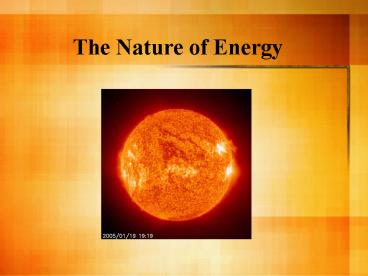The Nature of Energy - PowerPoint PPT Presentation
1 / 16
Title:
The Nature of Energy
Description:
The Nature of Energy Benchmarks Standard III: Physical Sciences E. Demonstrate that energy can be considered to be either kinetic (motion) or potential (stored). – PowerPoint PPT presentation
Number of Views:130
Avg rating:3.0/5.0
Title: The Nature of Energy
1
The Nature of Energy
2
Benchmarks
- Standard III Physical Sciences
- E. Demonstrate that energy can be considered to
be either kinetic (motion) or potential (stored). - F. Explain how energy may change form of be
redistributed but the total quantity of energy is
conserved. - G. Demonstrate that waves have energy and waves
can transfer energy when they interact with
matter. - H. Trace the historical development of
scientific theories and ideas, and describe
emerging issues in the study of physical
sciences.
3
What is Energy?
- Energy - ability to do work
- Work - force moves an object a distance
- W Fd
- units are Joules ( J ) for energy
- units for force are Newtons ( N )
- units for distance are meters ( m )
- A Joule can also be considered a Nm
4
States of Energy
- Potential Energy - stored energy, based on
position of chemical composition - Gravitational Potential Energy
- GPE mass x gravity x height
- GPE mgh --gt units Joules
- mmass (g) ggravity (9.8 m/s2) hheight (m)
- A 50kg rock is on the edge of a 20m cliff, what
is its GPE? - GPE m x g x h
- 50kg x 9.8m/s2 x 20m 9800J
5
States of Energy the Sequel
- Kinetic Energy - energy of motion, based on mass
and velocity of object - Kinetic Energy
- KE 1/2 mv2 --gt units Joules
- mmass (g) vvelocity (m/s)
- A 1000kg car is traveling 40m/s, what is its KE?
- KE 1/2mv2
- 1/2 x 100kg x (40m/s)2
- 1/2 x 100kg x 1600m2/s2 80,000J
6
Forms of Energy
- Six Forms of Energy
- Mechanical - moving objects perform work
- Ex wheels turning, hammer hitting a nail, sound
- Chemical - energy stored in the molecules of
substances - Ex coal, oil, nature gas, food
- Nuclear Energy - stored in nucleus of atom
- Ex Uranium used for fission
7
Forms of Energy
- Six Forms of Energy
- 4. Heat - energy caused by molecular motion
- Ex Rubbing hands together, lighting a match
- 5. Electrical - flow of electrons through a
conductor - Ex computers, televisions, generators
- 6. Light - radiant energy that moves in waves
- Ex sun, light bulbs, electromagnetic energy
8
Conservation of Energy and Matter
- The Law of Conservation of Energy
- energy can be neither created nor destroyed,
only transformed - The Law of Conservation of Matter
- matter can be neither created nor destroyed,
only rearranged - The total amount of matter and energy in the
always remains constant in the universe
9
Types of Energy
- RENEWABLE
- Solar energy harnessed from the sun
- Hydroelectric energy harnessed from the
Potential energy of water - Biomass energy harnessed agricultural and animal
waste products - Wind energy harnessed from the wind
- Geothermal energy harnessed from heat under
earths crust - http//library.thinkquest.org/20331/types/
10
- NONRENEWABLE
- Fossil fuels energy from natural gas, petroleum
and coal - Nuclear energy from fission and fusion
- What are the advantages and disadvantages of
each? - Energy brochure what type of energy do you think
Ohio should consider to help our energy demands
and decrease our dependence on coal.
http//www.puco.ohio.gov/puco/index.cfm/consumer-i
nformation/consumer-topics/where-does-ohioe28099s-
electricity-come-from/
11
Energy Transformations
- Energy can transform from one form to another
- Ex A black car absorbs light energy from the sun
and transforms it to heat energy to warm up the
car - During many energy transformations heat is
produced as an unwanted product - Ex Motors loose a great deal of energy to
unwanted heat energy
12
Nuclear Energy
- The three categories of forces are
- Gravitational Forces
- Electromagnetic Forces
- Nuclear Forces
- 1. Strong Force
- 2. Weak Force
- Nuclear forces are the strongest types
13
Fissionhttp//www.youtube.com/watch?vGy9JRQAffbo
- Fission is the process of splitting the nucleus
of an atom into two lighter weight nuclei
producing large amounts of energy - Bombarding Ur-235 or Pu with a neutron causes it
to split into Kr and Ba, and continues as a chain
reaction - Used in nuclear power plants and weapons
- Produces nuclear waste
14
Fusion
- Fusion is the process of combining two or more
lighter weight nuclei to form a heavier nucleus
releasing large amounts of energy - Hydrogen isotopes are converted to Helium under
extreme temperatures - Does not produce waste products, has abundant
resources (Hydrogen), and is safer than fission
15
Nuclear Reactor
- Nuclear reactors control the fission process by
using the heat produced to produce steam that
turns a turbine to produce electricity - The moderator and control rods slow the speed of
the fission reaction by absorbing neutrons - There is lead shielding around the core to
protect against radiation
16
Nuclear Incidents
- Meltdowns
- Chernobyl in Russia
- Recent Tsunami in Japan
- Partial Meltdowns
- -3 mile Island (1979, Harrisburg, Pa)
- -experimental partial meltdowns
- Fermi 1 (1966), Borax-1 (1954)

